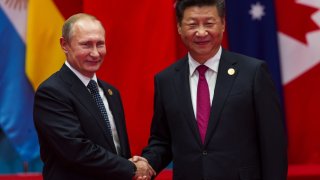Strategic Balances and Fractures: Russia, China, and Iran in Central Asia
While mutual antagonism towards the United States currently unites Russia, China, and Iran in Central Asia, their collaboration is more a strategic convenience than a deep-seated alliance.
Recent signs, however, point to a temporary lull in China’s commercial projects in the region, driven most likely by adverse domestic economic conditions. In spite of the recent signing of an agreement for the China-Kyrgyzstan-Uzbekistan railway, China’s foreign direct investment has reportedly slowed down significantly in 2024. This gives Western nations a chance to strengthen their partnership with Central Asian states. Western focus should be on providing the kind of investment that can foster the bottom-up regional growth and cooperation that underpins the B5+1 forum, for example, by building domestic and regional connections outside of the narrow east-west path that China’s BRI follows.
Once again, these policies will take time to bear fruits, and Western nations will need a short-term tactic to counter Chinese commercial dominance in the region. One option could be to allow India to trade with Central Asian Republics through the Iranian port of Chabahar, for which it had initially obtained a sanctions exemption in 2018. This would play into Iran’s desire to compete with China through the establishment of a north-south corridor, fuelled by the disappointing economic benefits of Iran’s cooperation with Beijing.
Keeping a Finger on the Pulse
The primary driver for cooperation among Russia, China, and Iran in Central Asia is their shared perception of mutual threats. The U.S. presence in the region, with its history of military bases and security cooperation, is seen as challenging its regional dominance. Similarly, the threat of terrorism and extremism, particularly from groups like ISIS and al-Qaeda, compels these nations to collaborate on counterterrorism efforts and intelligence sharing.
However, with the United States' relative disengagement from Central Asia and growing competition for its resources, the underlying conflicts of interest among these countries become more apparent. Russia, China, and Iran each aim to secure their energy needs and economic interests, leading to rivalries often masked by their cooperative façade against common threats.
Therefore, while mutual antagonism towards the United States and a desire to reshape the international order currently unites Russia, China, and Iran on a global level in Central Asia, their collaboration is more a strategic convenience than a deep-seated alliance. Beyond the surface, there are more conflicts than commonalities, underscoring the fragile nature of their cooperation in the region.
However, unless Western nations commit to a long-term plan for strategic engagement with Central Asia, it is unlikely that these simmering tensions will drive a wedge in their de facto alignment. To do so, Western countries should enact policies that encourage energy and trade competition among Russia, China, and Iran, as well as with other regional actors such as India and Turkey. This would give space to the Central Asian Republic to hedge by turning the regional dynamic into an economic and diplomatic “sellers’ market.”
Arman Mahmoudian is an adjunct professor at the University of South Florida’s Judy Genshaft Honors College, teaching courses on Russia, the Middle East, and International Security. He is also a research assistant at the USF Global and National Security Institute, focusing on Russia and the Middle East. Follow him on LinkedIn and X @MahmoudianArman.
Valentina Pegolo is a Junior Consultant at Plenitude Consulting and holds a Doctor of Philosophy in International Relations, a Master of Philosophy in International Relations, and a Bachelor of Arts in Philosophy, Politics, and Economics from the University of Oxford. Her research interests include Iranian foreign policy, political ideology, Eurasian geopolitics, global economic and technological interconnectedness, interstate and transnational political violence, and its relationship to financial crime.
Image: plavi011 / Shutterstock.com.

